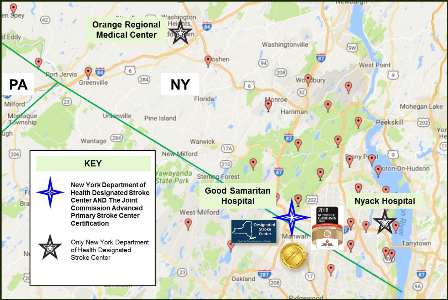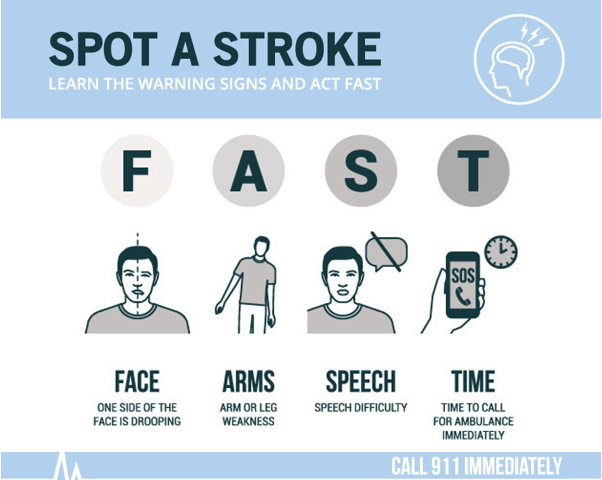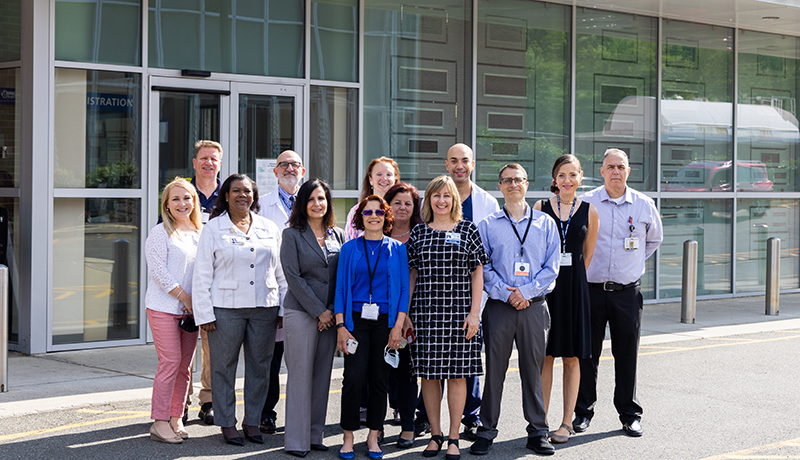
Experienced, Trusted Expertise
In the case of a stroke, prompt and effective treatment is vital for minimizing brain damage and improving chances of a successful recovery. Good Samaritan Hospital’s multi-disciplinary Stroke Center offers comprehensive care from prevention to rehabilitation with accredited treatment options and therapies centered on patient needs.

Good Samaritan Hospital’s Stroke Center was formed in the late 1990s as a response to the healthcare industry’s new focus on disease-specific management. From its inception, the program has been on the forefront of accountability, accreditation and quality care. It has been a New York State Designated Stroke Center since 2003 and a Joint Commission Certified Advanced Primary Stroke Center since 2004. Recently, New York State has required an advanced level of excellence for hospitals to be a Primary Stroke Center and Good Samaritan Hospital continues to keep the designation.
Good Samaritan is the only hospital in Rockland and Orange counties to have the Joint Commission Advanced Primary Stroke Center Certification. The Joint Commission’s gold seal is awarded to institutions that provide the most advanced stroke care to patients with exceptional, around-the-clock treatment. In order to receive this distinction, our Stroke Center underwent a rigorous onsite review during which Joint Commission experts evaluated compliance with stroke-related standards and requirements, including program management, the delivery of clinical care and performance improvement. It was determined that our Stroke Center thoroughly demonstrated the greatest level of commitment to the care of stroke patients and should be recognized as a leader in stroke treatment.
Since 2010, Good Samaritan Hospital has also been participating in the American Heart Association/American Stroke Association’s Get With The Guidelines program. In 2020, the Stroke Center received the Gold-Plus with Target: Stroke Honor Roll Elite for the third consecutive year. The program was also awarded the Target: Type 2 Diabetes Honor Roll Award.
The award recognizes the hospital’s commitment to ensuring stroke patients receive the most appropriate treatment according to nationally recognized, research-based guidelines based on the latest scientific evidence. Good Samaritan Hospital earned the award by meeting specific quality achievement measures for the diagnosis and treatment of stroke patients at a set level for a designated period. These measures include evaluation of the proper use of medications and other stroke treatments aligned with the most up-to-date, evidence-based guidelines with the goal of speeding recovery and reducing death and disability for stroke patients. Before discharge, patients should also receive education on managing their health, get a follow-up visit scheduled, as well as other care transition interventions.
Treatment Approach
Team Care
The team approach brings together a range of physicians and specialists to provide optimal stroke therapy. The Good Samaritan Stroke Center includes neurologists, neurosurgeons, critical care specialists across related departments, registered nurses with expertise in neurological care, nurse case managers and social workers. This multi-disciplinary team works closely to provide the best possible care for the patient and his or her family.
In keeping with the New York State Primary Stroke Center guidelines, Good Samaritan Hospital's Stroke Center has provides leadership for the stroke program through a Stroke Coordinator. The Stroke Coordinator acts as a
liaison with Emergency Medical Services in coordinating and evaluating pre-hospital care related to stroke services. This includes ensuring timely and accurate care for patients presenting with a stroke.
Advanced Treatment
The Stroke Center uses the latest technologies to diagnose and treat strokes accurately and effectively, including:
- Rapid imaging, diagnosis and treatment of patients suffering from acute ischemic stroke
- Administration of clot-busting medication known as TPA to reduce the long-term effects of stroke
- Identification of patients who will benefit from endovascular procedures which remove clots to restore blood flow to the brain.
Early Rehabilitation
Rehabilitation is integrated as early as possible, using state-of-the-art treatments not widely available at other centers in the Hudson Valley.
Listen
Are you at risk for a stroke? Learn the signs and symptoms and what you need to do if you or a loved one is experiencing a stroke. Mill Etienne, MD, neurologist at WMCHealth’s Good Samaritan Hospital, is interviewed on WRCR Radio.
It is important to note that not all of these warning signs happen in every case, but if you experience any of these symptoms, you must seek medical attention immediately. A stroke is a medical emergency – CALL 911.
Stroke Symptoms - FAST

FAST is an easy way to remember and identify the most common symptoms of a stroke. Recognition of stroke and calling 911 will determine how quickly someone will receive help and treatment. Getting to a hospital rapidly will more likely lead to a better recovery.
F FACE DROOPING: Does one side of the face droop or is it numb? Ask the person to smile.
A ARM WEAKNESS: Is one arm weak or numb? Ask the person to raise both arms. Does one arm drift downward?
S SPEECH DIFFICULTY: Is speech slurred, are they unable to speak, or are they hard to understand? Ask the person to repeat a simple sentence like, “The sky is blue.” Is the sentence repeated correctly?
T TIME TO CALL 911: If the person shows any of these symptoms, even if the symptoms go away, call 9-1-1 and get them to the hospital immediately.

Core Stroke Team
Stroke Medical Director, Neurologist, Mill Etienne, MD
Neurologist, Mill Etienne, MD
Neurologist, David Ober, MD
Neurologist John Ferro, MD
Neurology Nurse Practitioner, Laura Garcia, NP
Emergency Department Medical Director, Robin Kim, MD
Stroke Program Manager, Sherin Ninan, RN
Stroke Committee Members
Stroke Medical Director, Neurologist, Mill Etienne, MD
Emergency Department Medical Director, Robin Kim, MD
Director Cardiovascular Services, Tina Strazza, RN
Director of Patient Care Services, Anne Foran, RN & Karen Destefano, RN
Nursing Director, Emergency Department, Joan Osczepinski, RN
Stroke Program Manager-Sherin Ninan, RN
Director Hospitalist Program, Bijo Chacko, MD
Clinical Pharmacists, Steve Seeberger; RPH; Carolyn Maness PharmD, RPh
System Administrative Lab Director, Laura Degenhardt
System Director for Professional Development & Education, Gina Bolton, RN
Clinical Dietician, Kim Matthews, RN
Director of Rehabilitation, Howard Wilen, PT, MPT
Speech Language Pathologist, Michele Orestuk, MS, CCC-SLP
System Director Community Outreach, Kirby Zummo
System Director Emergency Management, Scott Frae
- Neurology
- Clinical Neurophysiology
- Nurse Practitioner, Acute Care